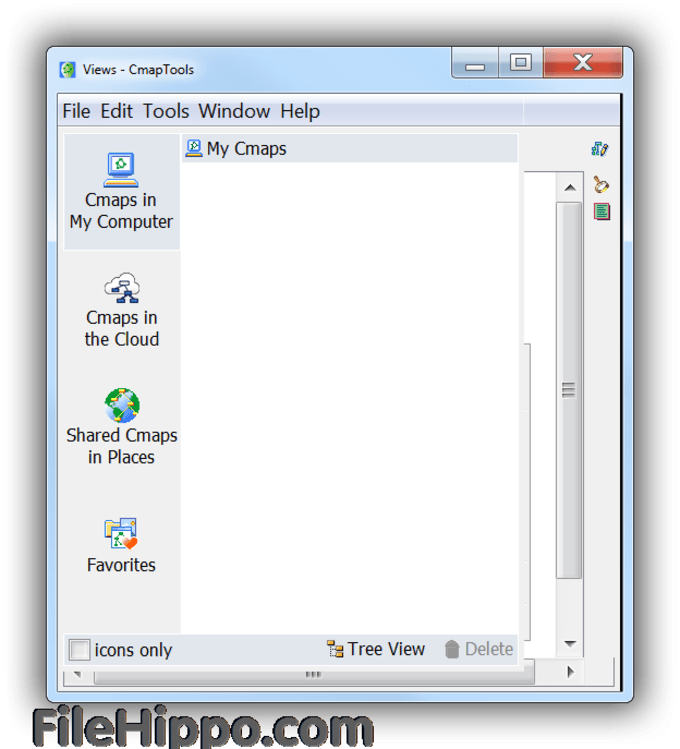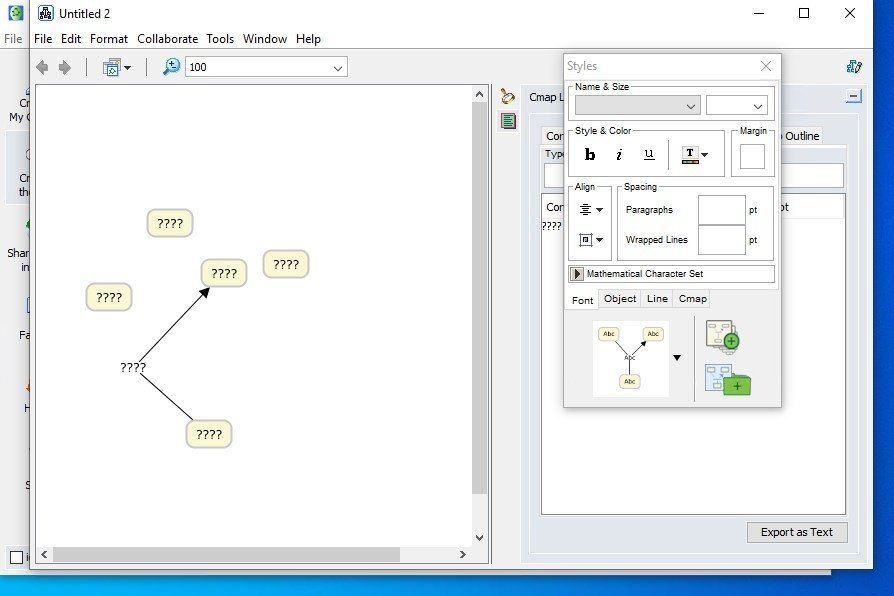The CmapTools program empowers users to construct, navigate, share and criticize knowledge models represented as concept maps. Among many other features, it allows users to construct their Cmaps in their personal computer, share them on servers (CmapServers) anywhere on the Internet, link their Cmaps to other Cmaps on servers, automatically create Web pages of their concept maps on servers, edit their maps synchronously (at the same time) with other users on the Internet, and search the Web for information relevant to a concept map.
The CmapTools client is free for use by anybody, whether its use is commercial or non-commercial. In particular, schools and universities are encouraged to download it and install it in as many computers as desired, and students and teachers may make copies of it and install it at home. (Commercial companies that install their own CmapServer do need to get a separate license for a CmapTools client that will talk to the commercial version of the CmapServer).

Note: While the software is classified as free, it is actually donationware. Please consider making a donation to help support development.
Bring our top-quality tools to professional technicians at countless dealerships and garages. This system has it all–customizable organization, high-end features, and expansion options. Save big with our best deals through 10/3, featuring our 10-pc Locking Pliers Set, Deluxe Compression Test Kit, and more. The latest version of CmapTools is unknown on Mac Informer. It is a perfect match for the Productivity category. The app is developed by Institute for Human & Machine Cognition and its user rating.
CMAP Tools is a concept mapping program from IHMC (the Institute for Human and Machine Cognition) in Florida.
In the documentation there is a heavy emphasis on collaboration and the sharing of maps. There are several public servers which can store your CMAPs so that they might be shared with others and IHMC provides the server software so that you can set up your own private server so that maps may be shared within an organisation.
CMAP Tools when used with the server software supports simultaneous collaborative editing of maps so that several people can edit the same map at the same time. It also has facilities for placing annotations on the map, making suggestions and setting up discussion threads (similar to a bulletin board or forum) to facilitate communications between separate users/viewers of the same map. Of all the programs reviewed here this one probably has the best facilities for supporting multiple users. Compendium is the next best and it’s multi user facilities are not as good although it comes close in my opinion.
There are versions of CMAP Tools for Windows, Mac OS X and Linux. A portable version is also available which can run from a USB memory stick.
CMAP Tools is free to download but you must first provide your details and a valid E-mail address. I have not received any spam E-mail from IHMC.
CMAP Tools is a good program but in my opinion for individual use VUE is even better. CMAP Tools is probably better at fast layout and capture of ideas but VUE is more expressive.
Overall score = 24 out of 50
1. Organisation = 6
The placement of nodes in CMAP Tools is completely manual. However having laid out your map you can get the program to re-arrange it for you but once the program has re-arranged your map the only way back is to manually drag everything back to the way it was, undo doesn’t work for the layout.
Concept maps are similar to mind maps but they have a different emphasis and use. Mind maps are arranged as a tree hierarchy whilst concept maps are a network. Concept maps can have descriptions associated with their links to define the relationship between the nodes being connected. Sentences can be implied by the concepts and their linking phrases. Mind maps generally do not have link phrases.
CMAP Tools can do both mind maps and cognitive maps but cognitive maps are easier to construct with this software. The links do have linking phrases and these can be linked to, so links can split and combine. Floating nodes are supported. You can have multiple maps on one sheet, the sheet is extremely large, I kept placing nodes further and further out but I was unable to find the limits of the sheet. You extend the sheet by trying to drag something past the edge of the sheet, the sheet just grows to accommodate it.

Nodes can link to other CMAPs (in a similar way to Compendium) which is useful in splitting subject matter into neat bundles, however each new map is a different file which can lead to a proliferation of files. Compendium’s system where all the sub maps are part of the same database is the better way to do this. Nodes and maps can be nested within other nodes but this is not the same as linking to a different map, the sub map can be expanded and folded away as needed.
As well as looking at the content of your map as a map you may also view it as an outline. CMAP Tools allows floating topics and annotations.
2. Attachments to nodes = 4

Nodes can contain ‘links to resources’. All the examples in the documentation refer to image files, but other types of resource can also be attached to nodes. To add a resource you either right click on a node and select the ‘Add & Edit links to resources …’ option from the context menu or just drag a file into the CMAP Tools window and drop it on a node.
Once the resource is attached there is the problem of how to use that resource. Unfortunately this is not very obvious from the documentation, I found it by messing about with the program. The first assumption I made was to double click the link, but nothing happens, I suspect that many people would do the same when first taking a look at the program. But that is not how you open a link in CMAP Tools. You single click on the link and a small box opens up containing the title of the resource (or a list if there are more than one) then you click on the name in the box.
If the link is to a data file then CMAP Tools opens the default program for that file, if the link is to a data file or to any executable file then an annoying dialog box opens to ask you if you really do want to open the link.
This program does not appear to support universal links.
Nodes can have information attached to them but this is not as useful as the notes attached to VUE nodes. When you select the Add Info… Option from either the Tools menu or from the context menu which appears when you right click on a node you get a dialog box with two panels, one is for the mouseover text, the other is hidden text. The mouseover text appears in a small box in very small writing when you move your mouse over the node, sort of like a tooltip. The other text is hidden and the only way you can view it is within the Add Info dialog box. The hidden text may seem pointless but it can be searched for and so it does mean that you can add keywords to nodes.
Neither of these facilities are very useful. If you add too much text to a node the whole program slows down to a crawl. The tooltip text is too small for comfortable reading of large bodies of text and the hidden text is just a bad way of implementing a proper keywords system. However you can link nodes to plain text files which can contain as much text as you like.
3. Appearance = 5
CMAP Tools has its own style. The default is boxes with slightly rounded corners and straight lines but the style of lines and nodes can be changed once they have been placed. It would have been nice to be able to change the default style. The range of looks available is quite good, colours of various elements can be set as well as nodes having drop shadows.
By default nodes and links are positioned manually. The map can have an image as its background.
C Map Tool Download Free Mac
4. Ease of use = 5
The program is easy to use and it is simple to make a layout with lots of nodes and links fast, just jotting down brief details to be fleshed out later, as such it would be good for use in a lecture theatre for quickly capturing the salient points of the lecture.
Cmaptools Download
The keyboard shortcuts are not customisable. Some aspects of the program are not very obvious (like links) but once you have figured out some of the more arcane aspects and with regular use it should become simple to operate.
The selected node is not placed in the centre of the screen. Positioning of the map is done by dragging sliders on the edge of the map. The map can be very large and an overview is available.


There is a tool for making presentations with your maps and it seems simpler and more straightforward to use than the one which comes with VUE. With VUE you set a path through your map, with CMAP Tools you define a series of slides which are to be presented full screen.
The program is easy to use but it has nothing to recommend it over VUE, however VUE does have several advantages over CMAP Tools.
5. Import – Export = 4
The import facilities of CMAP Tools are only available from the ‘Views’ window. It can import from a text file (although the format of this file is not given in the documentation), from a CMAP Outline, from an Inspiration file or a Life Map file and from .CXL .XTM .XCM and .IVML files. This may seem like an extensive list but if we were to eliminate the format only used by CMAP Tools then it becomes text, Inspiration or Life Map.
Inspiration is a commercial mind mapping and outlining tool, it is not expensive but beware if you want to buy it the company will only sell it to you if you are in America, they do not ship to the rest of the world, just another example of American parochial attitudes.
I was not able to find the Life Map application on a quick Google search but this might have been because the list was clogged with insurance companies wanting to provide me with a life map.
Cmap Tools Free Download Mac
The export facilities were more useful. The export functions are available from a menu on the map window itself. CMAP Tools exports to various image file formats, to .PDF and postscript files, to .SVG files, to a web page, to a text file, to a Life Map file or to the CMAP tools files, CMAP Outline, .CXL .XTM .XCM and .IVML formats.
Cmaptools App
The ability to export your map to an SVG file or a PDF file or a web page is especially useful and welcome. The .SVG files can be edited by Inkscape.